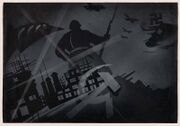Difference between revisions of "Airbrush"
(username removed) |
|||
| (2 intermediate revisions by 2 users not shown) | |||
| Line 1: | Line 1: | ||
| + | [[File:SC175326 MFA1989.156.jpg|thumb|Propaganda drawing<br>MFA# 1989.156]] | ||
| + | ==Description== | ||
| + | A small, hand-held, air-operated tool that atomizes and sprays various media, most often paint but also ink and dye. An airbrush delivers paint in a controlled spray. It is connected to a supply of compressed air by a flexible hose and draws paint from an integral reservoir or attached cup. Depending on the sophistication of the model, the user may control the supply of air and paint and the spray pattern in varying degrees. An airbrush works by passing a stream of fast moving (compressed) air through a venturi, which creates a local reduction in air pressure (suction) that allows paint to be pulled from an interconnected reservoir at normal atmospheric pressure. The high velocity of the air atomizes the paint into very tiny droplets as it blows past a very fine paint-metering component. The paint is carried onto paper or other surfaces. The first spray painting device that could be called an airbrush, was patented in 1876 (Patent Number 182,389) by Francis Edgar Stanley of Newton, Massachusetts. This worked akin to a diffuser/atomiser and did not have a continuous air supply. Stanley and his twin brother later invented a process for continuously coating photographic plates (Stanley Dry Plate Company) but are perhaps best known for their Stanley Steamer. | ||
| + | |||
== Synonyms and Related Terms == | == Synonyms and Related Terms == | ||
| − | aérograph (Fr.); bross à air (Fr.); Zerstäuber (Deut.); Spritzpistole (Deut.); aerografo (It.); aerografia (Esp.); | + | air brush; aérograph (Fr.); bross à air (Fr.); Zerstäuber (Deut.); Spritzpistole (Deut.); aerografo (It.); aerografia (Esp.); |
| − | == | + | ==Resources and Citations== |
| + | * J. Stephenson, 'Airbrush' Oxford Art Online, 2003. [https://www.oxfordartonline.com/browse?t=art_ArtHistory%3A80&t_0=art_ArtFormsAndPractices%3A34] | ||
| − | * | + | * Multilingual Glossary for Art Librarians at http://www.ifla.org/VII/s30/pub/mgl.htm |
| + | * Wikipedia: at https://en.wikipedia.org/wiki/Airbrush | ||
[[Category:Materials database]] | [[Category:Materials database]] | ||
Latest revision as of 07:55, 25 April 2022
Description
A small, hand-held, air-operated tool that atomizes and sprays various media, most often paint but also ink and dye. An airbrush delivers paint in a controlled spray. It is connected to a supply of compressed air by a flexible hose and draws paint from an integral reservoir or attached cup. Depending on the sophistication of the model, the user may control the supply of air and paint and the spray pattern in varying degrees. An airbrush works by passing a stream of fast moving (compressed) air through a venturi, which creates a local reduction in air pressure (suction) that allows paint to be pulled from an interconnected reservoir at normal atmospheric pressure. The high velocity of the air atomizes the paint into very tiny droplets as it blows past a very fine paint-metering component. The paint is carried onto paper or other surfaces. The first spray painting device that could be called an airbrush, was patented in 1876 (Patent Number 182,389) by Francis Edgar Stanley of Newton, Massachusetts. This worked akin to a diffuser/atomiser and did not have a continuous air supply. Stanley and his twin brother later invented a process for continuously coating photographic plates (Stanley Dry Plate Company) but are perhaps best known for their Stanley Steamer.
Synonyms and Related Terms
air brush; aérograph (Fr.); bross à air (Fr.); Zerstäuber (Deut.); Spritzpistole (Deut.); aerografo (It.); aerografia (Esp.);
Resources and Citations
- J. Stephenson, 'Airbrush' Oxford Art Online, 2003. [1]
- Multilingual Glossary for Art Librarians at http://www.ifla.org/VII/s30/pub/mgl.htm
- Wikipedia: at https://en.wikipedia.org/wiki/Airbrush
